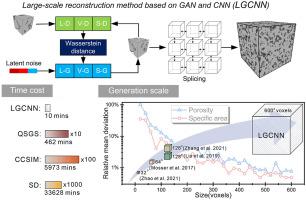Journal of Petroleum Science and Engineering ( IF 5.168 ) Pub Date : 2022-08-10 , DOI: 10.1016/j.petrol.2022.110937 HouLin Zhang , Hao Yu , SiWei Meng , MengCheng Huang , Marembo Micheal , Jian Su , He Liu , HengAn Wu

|
The accurate and efficient reconstruction of the porous media is the fundamental link to revealing its structural features and physical properties. In this work, we propose a deep learning (DL)-based algorithm to reconstruct large-scale three-dimensional (3D) porous media that can be treated as the representative element volumes (REVs), based on generative adversarial networks (GAN) and convolutional neural networks (CNN), named LGCNN. The proposed framework consists of a machine learning based (ML-based) reconstruction method for small-scale porous media and an adjustable splicing algorithm to achieve the REVs reconstruction. On this basis, four special neural networks are established to reconstruct the porous media and ensure the connectivity between the adjacent porous media during the splicing process. Subsequently, the detailed validation of LGCNN against traditional reconstruction methods and other deep learning algorithms is performed. The results show that the reconstruction speed (6003 voxels) of LGCNN (10 min) is much faster than traditional numerical reconstruction methods including QSGS (642 min), CCSIM (5973 min), and SD (33,628 min) with higher accuracy on structural parameters (e.g., porosity and pore size distribution), when compared with real porous media. In particular, the size of constructed porous media is far larger than previous ML-based reconstruction algorithms as much as 3–4 orders of magnitude, indicating the puissant ability of LGCNN to be used for high-resolution or multi-scale reconstruction.
中文翻译:

使用深度学习快速准确地重建大规模 3D 多孔介质
多孔介质的准确高效重构是揭示其结构特征和物理性质的根本环节。在这项工作中,我们提出了一种基于深度学习 (DL) 的算法,基于生成对抗网络 (GAN) 和卷积神经网络 (CNN),命名为 LGCNN。所提出的框架包括一种基于机器学习(基于机器学习)的小型多孔介质重建方法和一种可调节的拼接算法来实现 REVs 重建。在此基础上,建立了四个特殊的神经网络对多孔介质进行重构,保证拼接过程中相邻多孔介质之间的连通性。随后,执行了 LGCNN 针对传统重建方法和其他深度学习算法的详细验证。结果表明,重建速度(600LGCNN(10 分钟)的3个体素比传统的数值重建方法(包括 QSGS(642 分钟)、CCSIM(5973 分钟)和 SD(33,628 分钟))快得多,结构参数(例如孔隙率和孔径分布)的精度更高),与真实的多孔介质相比。特别是,构建的多孔介质的尺寸远大于以前的基于 ML 的重建算法高达 3-4 个数量级,这表明 LGCNN 用于高分辨率或多尺度重建的强大能力。


























 京公网安备 11010802027423号
京公网安备 11010802027423号